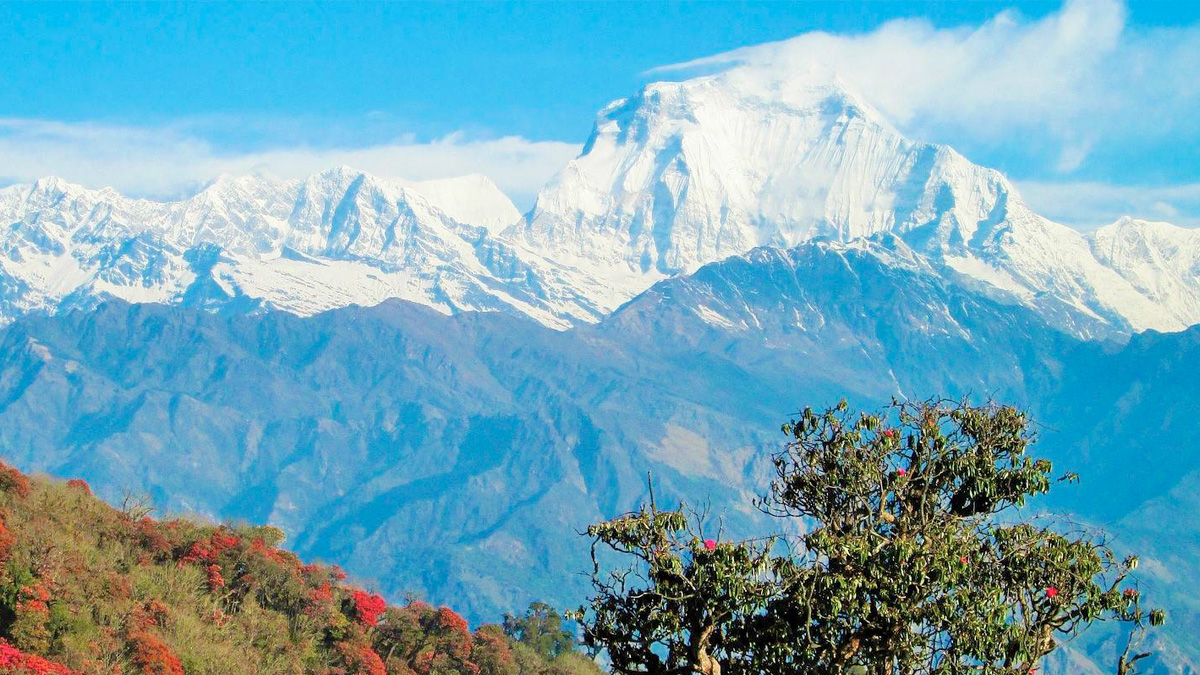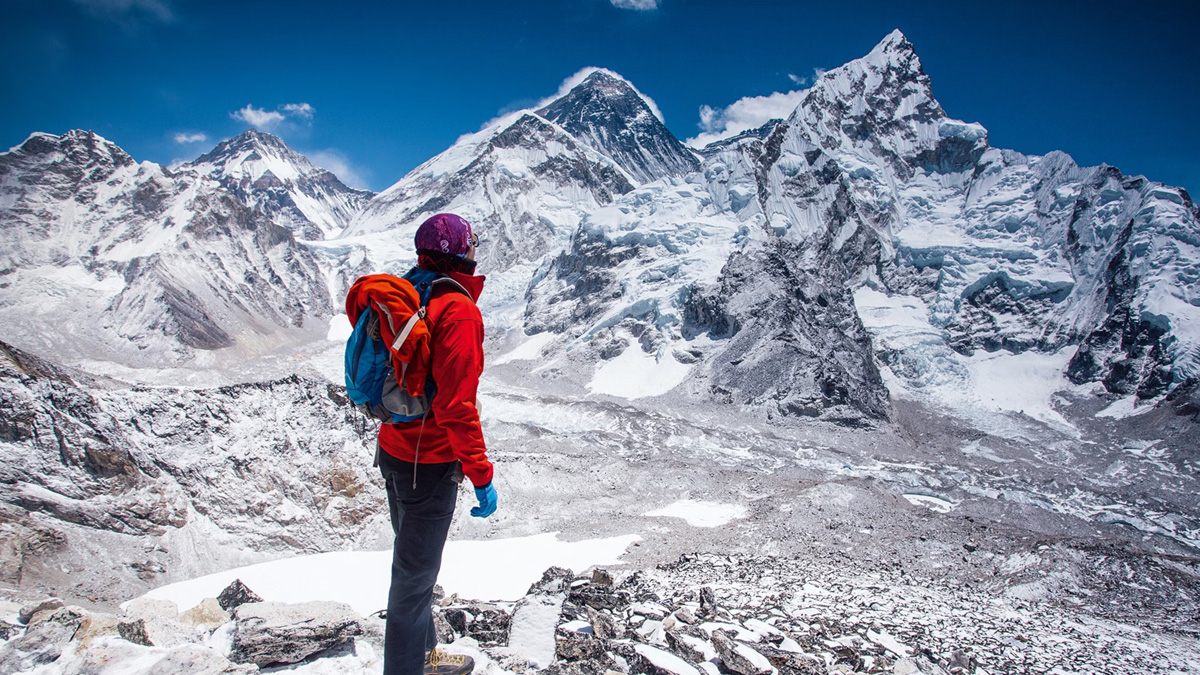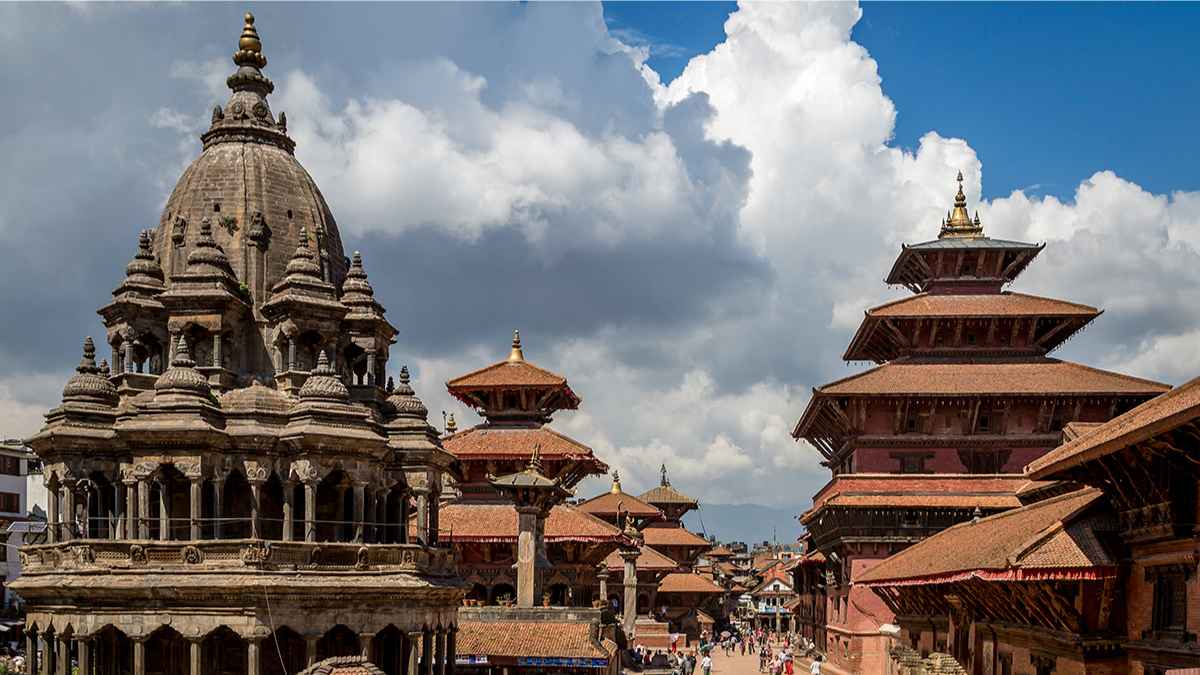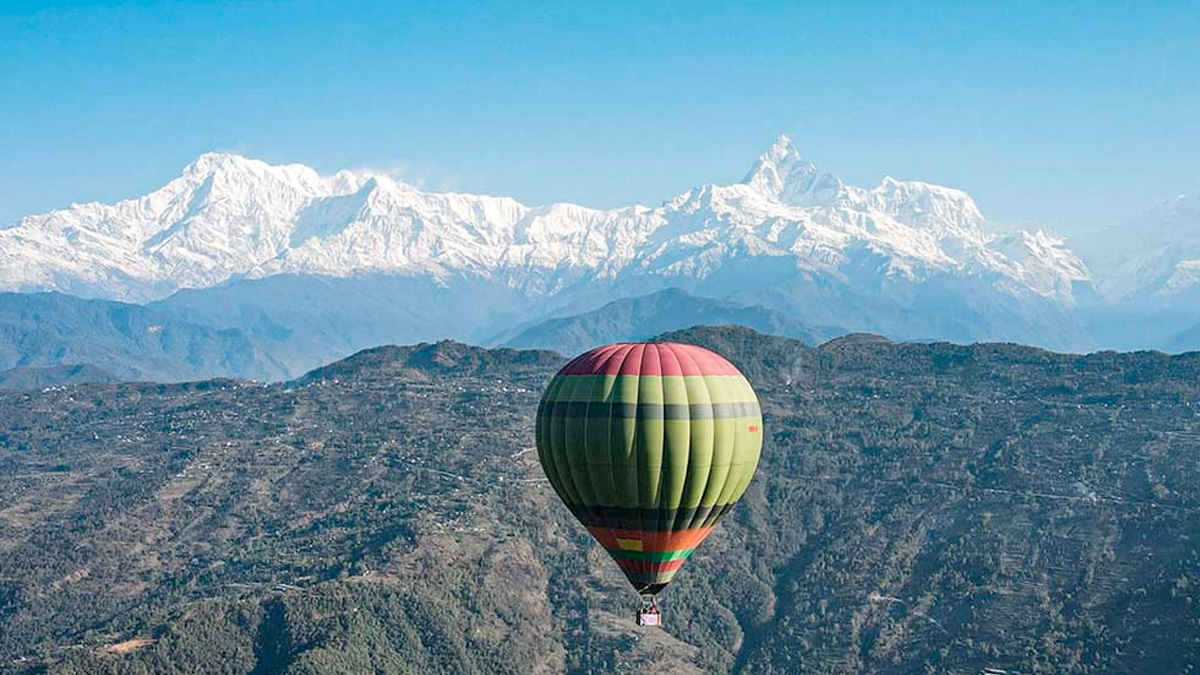The Everest Base Camp Trek is one of the world’s most iconic journeys — a thrilling adventure through Nepal’s majestic Himalayan landscapes where every step brings you closer to the roof of the world. With breathtaking views of Mount Everest (8,848.86 m) and neighboring peaks like Lhotse, Nuptse, and Ama Dablam, this trek is a lifelong dream for many adventurers. But before setting foot on this legendary trail, one of the most important questions to ask is: “When is the best time to trek to Everest Base Camp?”
Choosing the right trekking season is key to enjoying clear mountain views, comfortable weather, and safe trails. Spring is widely considered the best time for Everest Base Camp trekking. During these months, the skies are generally clear, temperatures are moderate, and the rhododendron forests along the trail bloom in vibrant shades of red, pink, and purple. The average daytime temperature ranges from 10°C to 15°C (50°F to 59°F) at lower elevations, dropping below freezing at higher altitudes.
This season is also the most active time for Everest climbers, as Base Camp becomes a lively hub for mountaineering expeditions. If you want to witness the excitement of climbers preparing for their Everest ascent, April and May are perfect. The long daylight hours and stable weather conditions make it ideal for both trekking and photography.
The Autumn season is another peak time for Everest Base Camp trekking. After the summer monsoon, the air becomes crisp and clean, revealing panoramic views of snow-covered peaks under deep blue skies. The average daytime temperatures range from 12°C to 16°C (54°F to 61°F) at lower altitudes, making it comfortable for long hikes.
The trails are filled with trekkers, but the weather is stable, visibility is excellent, and the landscapes are at their most photogenic. The major festivals of Nepal, such as Dashain and Tihar, also fall during this time, adding a rich cultural experience to your adventure.
Winter brings cold temperatures and snow at higher altitudes, but it also offers quiet trails and crystal-clear mountain views. For well-prepared trekkers with good gear, winter Everest trekking can be an incredibly peaceful experience. Expect daytime temperatures from 5°C to 10°C (41°F to 50°F) and much colder nights.
You’ll find fewer crowds, cozy tea houses, and plenty of opportunities for stunning photography in clear winter light. However, some high passes may be blocked by snow, so trekking with an experienced guide is highly recommended.
Table of Contents – Your Ultimate Everest Base Camp Trek Guide
- Spring (March–April–May): The Best Time to Trek to Everest Base Camp – crystal-clear skies, colorful rhododendrons, and perfect weather for adventure!
- Autumn (September–October–November): The Most Popular Season to Conquer EBC – stable weather, jaw-dropping mountain views, and lively Sherpa villages.
- Everest Base Camp Trek in the Monsoon (June–August): Lush trails, blooming valleys, and a quieter, more intimate Himalayan experience.
- Everest Base Camp Trek in Winter (December–January): Serenity in the snow! Fewer trekkers, crisp blue skies, and magical frozen landscapes.
Best Time for Everest Base Camp Trek – Spring (March to May)

The best time for the Everest Base Camp Trek is undoubtedly spring (March–April–May) — the season when the Himalayas come alive with color, clarity, and adventure. This period offers the perfect balance of pleasant weather, clear skies, and cultural energy, making it the most popular season for Everest trekking in Nepal.
At lower elevations like Lukla (2,860m), daytime temperatures range between 10°C–18°C, ensuring comfortable hiking conditions. As trekkers ascend toward Everest Base Camp (5,364m), temperatures cool to 3°C–7°C in the day and may drop to –5°C to –8°C at night, creating crisp and refreshing trekking days.
Spring also paints the trails with vibrant blooms of Nepal’s national flower, the rhododendron, splashing the hills with pink, red, and white hues—especially stunning between March and April. With clear blue skies, trekkers are rewarded with awe-inspiring views of Mount Everest, Lhotse, and Ama Dablam—a true photographer’s dream.
This is also the Everest climbing season, so the Base Camp buzzes with expedition excitement, offering a rare glimpse into the mountaineering spirit. Flight operations to Lukla are generally stable and reliable during spring, minimizing weather delays.
However, due to high demand, routes and teahouses can get busy, so it’s wise to book flights and lodges in advance for a smooth, unforgettable Everest Base Camp trekking experience.
Best Time for Everest Base Camp Trek – Why Autumn (September to November) is Perfect

If you’re wondering when is the best time for the Everest Base Camp Trek, the answer is clear — autumn (September, October, and November) is the golden season. This time of year offers the most stunning views of the Himalayas, stable weather, and an ideal balance of temperature, culture, and adventure. For trekkers searching online for Everest Base Camp trek weather, best season for EBC trek, or Everest Base Camp trek in October, autumn consistently tops every list.
During these months, the skies are crystal clear, unveiling jaw-dropping panoramas of Mount Everest (8,848m), Lhotse, and Ama Dablam. The landscapes glow in rich colors, and the crisp mountain air enhances every step of your journey. Daytime temperatures at lower altitudes like Lukla (2,860m) average between 10°C and 20°C (50°F–68°F), while higher regions like Everest Base Camp (5,364m) and Kala Patthar (5,545m) maintain pleasant trekking temperatures of 5°C–10°C (41°F–50°F). Nights can drop to –10°C or even –15°C, but with proper gear, the chill only adds to the high-altitude adventure.
Another reason autumn is the best time to trek to Everest Base Camp is the vibrant cultural atmosphere. Nepal’s biggest festivals, Dashain and Tihar, fall during this season. The trails come alive with colorful prayer flags, festive music, and the warm hospitality of the Sherpa people. Many trekkers find that these cultural celebrations deepen their connection to Nepal beyond the physical journey, transforming the Everest Base Camp trek into a truly soulful experience.
The autumn season also ensures safe and comfortable trekking conditions. The monsoon rains have cleared the dust and pollution, revealing a pristine Himalayan skyline. Trails are well-defined, teahouses are open, and you’ll meet fellow adventurers from all over the world — sharing stories, laughter, and unforgettable memories under starry skies.
For those who prefer solitude, late November offers quieter trails and peaceful mountain serenity. The weather remains favorable, but the crowds thin, allowing for a more introspective and personal experience.
Trekking to Everest Base Camp in the Monsoon (June-August)

If you’re considering the Everest Base Camp trek during the monsoon season (approximately June to mid-September), you’ll find this off-peak period offers an entirely different flavour of the Nepal trekking experience. While spring and autumn remain the “high-search” seasons for “Everest Base Camp trek cost” the monsoon window holds its own special appeal — and demands extra care.
What the weather and trail conditions look like:
- At lower altitudes (below ~3,500 m), you’ll likely face frequent rainfall, muddy or slick trails, and humid conditions.
- As you ascend above ~3,500 m towards the high Khumbu region and the base camp zone, precipitation tends to reduce, but you’ll still contend with damp conditions and possibly night-time lows around −5 °C.
- Daytime temperatures in lower regions may reach into the 20-22 °C (71 °F) range, while higher up the days stay cool and nights become cold. The skies may be clouded and visibility limited.
Why you might choose this season (and why it’s unique):
- Fewer crowds & more solitude: With many trekkers avoiding monsoon months, you’ll often have the trail, teahouses and viewpoints with far fewer people — ideal if you seek a quieter “Everest Base Camp trek experience without the crowds”.
- Lush landscapes & wild beauty: The rain rejuvenates the valleys, and you’ll see vibrant wildflowers, lush greenery, rushing waterfalls and a live-nature feel in the Himalayas c/w “peak season” dry trails.
The trade-offs & what to prepare for:
- Trail hazards: Mud, slippery surfaces, leeches and increased insect activity can occur especially in forested or lower trail sections.
- Visibility & views: Clouds frequently obscure mountain vistas, so while you’re on the classic “EBC trek” search keywords, you may not get the same crystal-clear views as spring or autumn.
- Flight & logistics risk: The gateway flight to Lukla (the common start point) may face delays or cancellations due to weather. Build in extra buffer days.
- Gear & flexibility required: Waterproof jacket/pants, backpack cover, good trekking boots, insect repellent, trekking poles — all become more critical. Opt for an itinerary with flexibility.
Is the Monsoon Time Still a Good Choice for the Everest Base Camp Trek?
Yes — if you’re comfortable with the trade-offs and looking for a trekking experience of the “less travelled” variety. Many standard guides list the monsoon months as the least ideal for Everest Base Camp trekking due to heavy rainfall, muddy trails and reduced views. However, for a smaller-crowd, nature-rich, slightly unpredictable but deeply rewarding journey — it can be a perfect match.
Everest Base Camp Trek in Winter (December – February)

If you’re searching for a quiet and magical Everest Base Camp hike, the winter season might be perfect. Trekking to Everest Base Camp during winter offers a peaceful, crowd-free experience, where you can enjoy the untouched beauty of the snow-covered Himalayas. The trails are far less busy compared to peak seasons, allowing you to connect deeply with nature and experience the mountain’s solitude in its purest form.
Winter in the Everest region is marked by clear skies, dry air, and cold temperatures. In lower altitudes such as Lukla (2,860 m), days can reach around 10°C (50°F), while nights may drop to -5°C (23°F). At Everest Base Camp (5,364 m), daytime temperatures range between -5°C to -10°C (23°F to 14°F), and nights can plunge to -20°C (-4°F) or even lower. The upside? Visibility is incredible, offering panoramic mountain views and dazzling sunrises over Mount Everest, Lhotse, and Ama Dablam.
Why Trek Everest Base Camp in Winter?
Despite the cold, Everest Base Camp trekking in winter is a rewarding and soulful adventure. The snow-blanketed trails and frozen waterfalls transform the Khumbu region into a winter wonderland, perfect for photographers and nature lovers. You’ll find fewer trekkers, open skies, and peaceful teahouses, making the journey more intimate and reflective.
However, trekkers must be well-prepared. Proper winter gear—insulated jackets, waterproof boots, warm sleeping bags, and layered clothing—is essential. Some teahouses at higher elevations may close due to the cold, so pre-booking accommodations and travel insurance for flight delays are highly recommended, especially as Lukla flights may face weather-related disruptions.
Most Frequently Asked Questions About Everest Base Camp Weather
Planning your Everest Base Camp Trek and wondering how cold it gets? Understanding the Everest Base Camp weather is one of the most important parts of preparing for this once-in-a-lifetime adventure. The temperatures vary greatly depending on the season, altitude, and time of day — from pleasant daytime warmth to freezing nights beneath the stars.
At Everest Base Camp (5,364 m), the temperature can range anywhere from +20°C to -5°C during the day, dropping well below -20°C on winter nights. Due to the high altitude and thin mountain air, the weather changes quickly, so being prepared for all conditions is essential.
Everest Base Camp Weather by Season
- Winter (December–February): This is the coldest time of year in the Everest region. Daytime temperatures average around 5°C, while nights can drop to -10°C to -30°C (-4°F to -22°F). Days are often clear, offering stunning views of snow-covered peaks, but the trails are quieter due to the extreme cold.
- Spring (March–May): The most popular season for trekking. Daytime temperatures range between 5°C and 10°C (41°F–50°F), with nighttime lows near -10°C. The skies are generally clear, and rhododendrons bloom along the trail — making spring the best time for Everest Base Camp Trek.
- Summer/Monsoon (June–August): Expect warmer days around 10°C–20°C (50°F–68°F), but with occasional rainfall, especially at lower elevations. While trails may be slippery, the mountains are lush and green, offering a unique trekking experience with fewer crowds.
- Autumn (September–November): Another ideal trekking season. Daytime highs range from 10°C to 20°C (50°F–68°F) with crisp, cool evenings around -10°C. The air is clean and dry, providing excellent mountain views. This is considered the best season for Everest Base Camp Trek due to its stable weather and crystal-clear skies.
Everest Base Camp Temperature by Month
-
January: -20°C to -10°C (very cold, clear skies)
- April: -5°C to +5°C (mild, colorful landscapes)
- May: 0°C to +10°C (peak trekking season)
- October: -5°C to +5°C (ideal weather, high visibility)
- December: -20°C to -10°C (freezing nights, clear days)
Why It Feels Colder at High Altitude
At high elevations, air pressure decreases, and winds intensify, increasing the chill factor. Less sunlight and thin air make it feel even colder than the thermometer suggests. Whether you’re visiting in spring or autumn, it’s crucial to pack for extreme variations — warm layers, windproof jackets, gloves, and proper sleeping bags are essential for a comfortable trek.

Why These Seasons Are Ideal for the EBC Trek
- Choosing spring or autumn for your Everest region trekking trip ensures several benefits:
- Clear mountain views — With minimal haze or clouds, you’ll likely enjoy spectacular vistas of snow-capped peaks.
- Comfortable daytime temperatures — Lower elevations may reach 10-20 °C; higher camps are cold, but the daytime trekking is manageable.
- Safer and more reliable conditions — The risks of heavy rain (monsoon) or deep snow (winter) are much reduced. Trails are more stable, flights into the region are more dependable.
- Natural beauty and colour — Spring brings the bloom of rhododendrons and wildflowers; autumn offers dramatic foliage and post-monsoon clarity.
- Popular and operational — Lodges and teahouses are open, flights to the region (such as to Lukla) run reliably, services operate at full capacity.
Is April a Good Month to Visit Everest Base Camp?
Absolutely. April falls in the heart of spring-season trekking. The trails become alive with colour, especially rhododendrons, and the landscapes transform from winter’s grey into vibrant hues. The weather tends to be stable, with clear skies and excellent visibility. Daytime temperatures at lower elevations (e.g., near Namche Bazaar) may range from ~2 °C to ~15 °C; higher points like Gorak Shep (5 180 m) will still feel quite cold at night (down to around –4 °C). Your trekking experience will be enhanced by the combination of good weather and scenic beauty.
What About Other Seasons?
Yes, the trail to Everest Base Camp is open year-round—but each season brings trade-offs:
- Summer/Monsoon (June – August): Technically possible, but this is the wettest period. Heavy rain, slippery trails, delayed flights, and cloud-cover that hides the views. Some trekkers still go, but you’ll need extra flexibility, good rain kit, and realistic expectations.
- Winter (December – February): The trails become quieter, and if you’re equipped with proper gear you’ll enjoy striking snow-scapes and solitude. However: extreme cold, shorter daylight hours, some high-altitude lodges may be closed, and flights can be unpredictable.
Choosing Your Month: Crowd or Calm?
- Peak crowd months: April and October are the busiest. Expect more trekkers, busier teahouses, higher costs—but also optimal weather and stunning views.
- Shoulder months (early March, late November): Slightly cooler, maybe fewer services, but lighter crowds and still very good conditions.
- Avoid: Mid-June to early September if you want clear views and dry trails; winter months if you prefer easier conditions and full services.
What are the benefits of trekking in spring season?
Spring in Nepal unfolds gently and beautifully, signalling a season of balance, renewal and ease for mountain travellers. As winter’s strict chill begins to fade, trails soften, the air becomes kinder, and the sky opens to clear vistas. For those who venture on the iconic Everest Base Camp trek during March to May, the benefits are numerous. This spring-trekking window offers mild temperatures, stable weather, vivid landscapes and a sense of calm on one of the world’s most awe-inspiring paths.
Comfortable, Inviting Weather
In spring you’ll find more moderate daytime temperatures—especially below high altitude—creating a comfortably paced trek. Conditions on the Everest Base Camp route during March in particular tend to favour warmer days (often around 10 °C to 15 °C at mid‐elevations), with considerably less snow or rain to contend with. This means your ascent is more about the journey and less about battling elements. On the mountain trails, the chances of rain or snow are reduced, making your hike clearer and drier. According to trekking-season guides, spring in Nepal offers “moderate climate, clear sky” and fewer weather‐related cancellations.
Clear Skies, Stunning Mountain Views
With less moisture and fewer storms to cloud the peaks, spring treks deliver magnificent visibility. The skies often remain clear, allowing panoramic views of towering peaks and deep valleys that define the Everest region. Guides consistently mention spring as a season when visibility improves and the “mountain views are at their best”. Early starts often reveal dramatic ridges of the Himalayas, and with less likelihood of heavy snowfall, even high passes open more reliably.
Nature’s Vibrant Renewal
One of the most celebrated advantages of spring trekking in Nepal is the explosion of wildflowers—especially the nationwide colour of rhododendrons. The ridges and forests wake up with bright reds, pinks, and whites, lending each day of the trek a vivid new backdrop. This burst of flora adds both aesthetic magic and a deeper connection to the landscape. Walking through rhododendron forests in full bloom can feel like stepping into a shifting tapestry of nature’s own design.
Less-Crowded Trails & Better Accessibility
Compared to the extremely busy autumn season (September-November), spring treks offer somewhat quieter trail conditions. Fewer trekkers and more available teahouses mean you might find it easier to secure accommodation or simply enjoy a more peaceful pace. The more stable spring weather also means fewer cancellations of flights (e.g., into the Khumbu region) and improved access to key routes and passes.
Longer Days, Better Planning
Spring brings increased daylight hours, which in turn offers more flexibility for each day’s trek—whether that means a slower morning, additional photo stops, or ample time to reach your next lodge before dark. Guides note that trekking in spring benefits from “more daylight” and more comfortable day-to-day scheduling. With softer light and mild temperatures, you’ll be better positioned to savour the journey rather than rush through it.
Practical Things to Keep in Mind
- Although rain and snow are less likely than at other times of year, occasional showers or trail‐slipperiness can still occur—especially in late spring as monsoon patterns begin creeping in.
- Nights and early mornings remain cold—especially above 3,000-4,000 m—so layered warm clothing and a good sleeping bag are still essential.
- As spring advances into May, lower elevations can warm up significantly, and pre-monsoon haze may reduce distant peak visibility in the afternoons.
- Though less crowded than autumn, spring is still popular—so booking permits, flights and accommodations ahead of time is wise.
Conclusion
The Everest Base Camp Trek is a life-changing adventure through Nepal’s majestic Himalayas. Spring (March–May) and autumn (September–November) offer the best trekking conditions with clear skies, stable weather, and breathtaking mountain views. Whether you prefer spring’s rhododendron blooms or autumn’s crystal clarity, both seasons promise safe trails, cultural richness, and unforgettable moments beneath the world’s highest peaks.



-1.webp&w=3840&q=75&dpl=dpl_GDHRyonDC5uCJ5MtiFRDmK8W8YHj)






